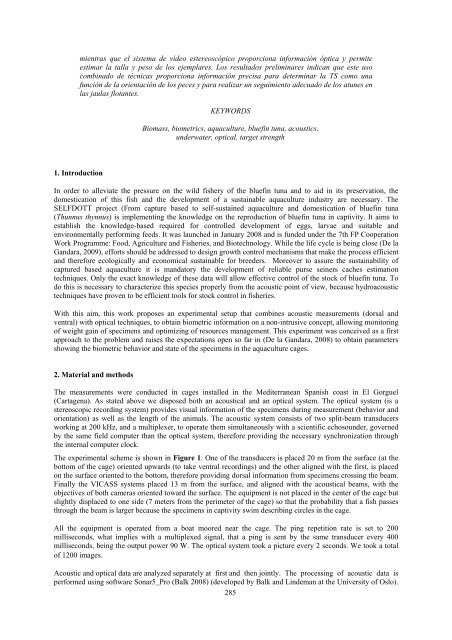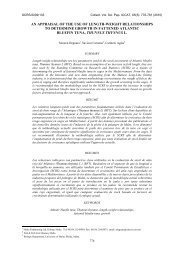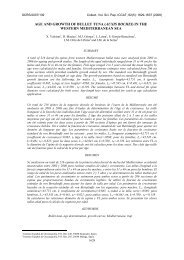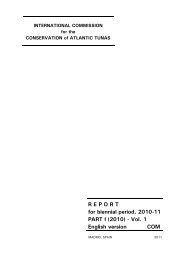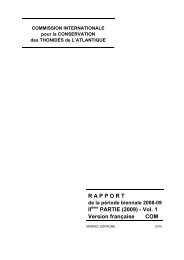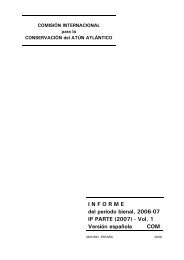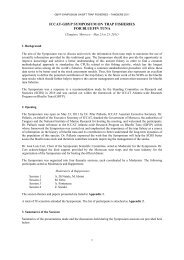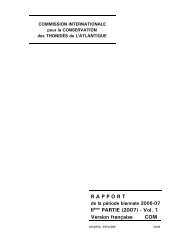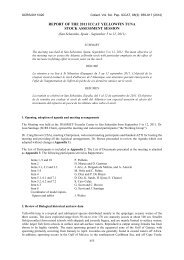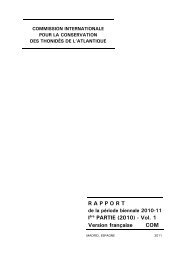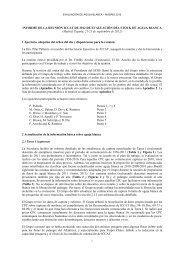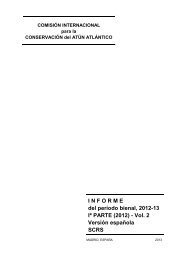biomass estimation of bluefin tuna in sea cages by the ... - Iccat
biomass estimation of bluefin tuna in sea cages by the ... - Iccat
biomass estimation of bluefin tuna in sea cages by the ... - Iccat
You also want an ePaper? Increase the reach of your titles
YUMPU automatically turns print PDFs into web optimized ePapers that Google loves.
mientras que el sistema de vídeo estereoscópico proporciona <strong>in</strong>formación óptica y permiteestimar la talla y peso de los ejemplares. Los resultados prelim<strong>in</strong>ares <strong>in</strong>dican que este usocomb<strong>in</strong>ado de técnicas proporciona <strong>in</strong>formación precisa para determ<strong>in</strong>ar la TS como unafunción de la orientación de los peces y para realizar un seguimiento adecuado de los atunes enlas jaulas flotantes.KEYWORDSBiomass, biometrics, aquaculture, <strong>bluef<strong>in</strong></strong> <strong>tuna</strong>, acoustics,underwater, optical, target strength1. IntroductionIn order to alleviate <strong>the</strong> pressure on <strong>the</strong> wild fishery <strong>of</strong> <strong>the</strong> <strong>bluef<strong>in</strong></strong> <strong>tuna</strong> and to aid <strong>in</strong> its preservation, <strong>the</strong>domestication <strong>of</strong> this fish and <strong>the</strong> development <strong>of</strong> a susta<strong>in</strong>able aquaculture <strong>in</strong>dustry are necessary. TheSELFDOTT project (From capture based to self-susta<strong>in</strong>ed aquaculture and domestication <strong>of</strong> <strong>bluef<strong>in</strong></strong> <strong>tuna</strong>(Thunnus thynnus) is implement<strong>in</strong>g <strong>the</strong> knowledge on <strong>the</strong> reproduction <strong>of</strong> <strong>bluef<strong>in</strong></strong> <strong>tuna</strong> <strong>in</strong> captivity. It aims toestablish <strong>the</strong> knowledge-based required for controlled development <strong>of</strong> eggs, larvae and suitable andenvironmentally perform<strong>in</strong>g feeds. It was launched <strong>in</strong> January 2008 and is funded under <strong>the</strong> 7th FP CooperationWork Programme: Food, Agriculture and Fisheries, and Biotechnology. While <strong>the</strong> life cycle is be<strong>in</strong>g close (De laGandara, 2009), efforts should be addressed to design growth control mechanisms that make <strong>the</strong> process efficientand <strong>the</strong>refore ecologically and economical susta<strong>in</strong>able for breeders. Moreover to assure <strong>the</strong> susta<strong>in</strong>ability <strong>of</strong>captured based aquaculture it is mandatory <strong>the</strong> development <strong>of</strong> reliable purse se<strong>in</strong>ers caches <strong>estimation</strong>techniques. Only <strong>the</strong> exact knowledge <strong>of</strong> <strong>the</strong>se data will allow effective control <strong>of</strong> <strong>the</strong> stock <strong>of</strong> <strong>bluef<strong>in</strong></strong> <strong>tuna</strong>. Todo this is necessary to characterize this species properly from <strong>the</strong> acoustic po<strong>in</strong>t <strong>of</strong> view, because hydroacoustictechniques have proven to be efficient tools for stock control <strong>in</strong> fisheries.With this aim, this work proposes an experimental setup that comb<strong>in</strong>es acoustic measurements (dorsal andventral) with optical techniques, to obta<strong>in</strong> biometric <strong>in</strong>formation on a non-<strong>in</strong>trusive concept, allow<strong>in</strong>g monitor<strong>in</strong>g<strong>of</strong> weight ga<strong>in</strong> <strong>of</strong> specimens and optimiz<strong>in</strong>g <strong>of</strong> resources management. This experiment was conceived as a firstapproach to <strong>the</strong> problem and raises <strong>the</strong> expectations open so far <strong>in</strong> (De la Gandara, 2008) to obta<strong>in</strong> parametersshow<strong>in</strong>g <strong>the</strong> biometric behavior and state <strong>of</strong> <strong>the</strong> specimens <strong>in</strong> <strong>the</strong> aquaculture <strong>cages</strong>.2. Material and methodsThe measurements were conducted <strong>in</strong> <strong>cages</strong> <strong>in</strong>stalled <strong>in</strong> <strong>the</strong> Mediterranean Spanish coast <strong>in</strong> El Gorguel(Cartagena). As stated above we disposed both an acoustical and an optical system. The optical system (is astereoscopic record<strong>in</strong>g system) provides visual <strong>in</strong>formation <strong>of</strong> <strong>the</strong> specimens dur<strong>in</strong>g measurement (behavior andorientation) as well as <strong>the</strong> length <strong>of</strong> <strong>the</strong> animals. The acoustic system consists <strong>of</strong> two split-beam transducerswork<strong>in</strong>g at 200 kHz, and a multiplexer, to operate <strong>the</strong>m simultaneously with a scientific echosounder, governed<strong>by</strong> <strong>the</strong> same field computer than <strong>the</strong> optical system, <strong>the</strong>refore provid<strong>in</strong>g <strong>the</strong> necessary synchronization through<strong>the</strong> <strong>in</strong>ternal computer clock.The experimental scheme is shown <strong>in</strong> Figure 1. One <strong>of</strong> <strong>the</strong> transducers is placed 20 m from <strong>the</strong> surface (at <strong>the</strong>bottom <strong>of</strong> <strong>the</strong> cage) oriented upwards (to take ventral record<strong>in</strong>gs) and <strong>the</strong> o<strong>the</strong>r aligned with <strong>the</strong> first, is placedon <strong>the</strong> surface oriented to <strong>the</strong> bottom, <strong>the</strong>refore provid<strong>in</strong>g dorsal <strong>in</strong>formation from specimens cross<strong>in</strong>g <strong>the</strong> beam.F<strong>in</strong>ally <strong>the</strong> VICASS systems placed 13 m from <strong>the</strong> surface, and aligned with <strong>the</strong> acoustical beams, with <strong>the</strong>objectives <strong>of</strong> both cameras oriented toward <strong>the</strong> surface. The equipment is not placed <strong>in</strong> <strong>the</strong> center <strong>of</strong> <strong>the</strong> cage butslightly displaced to one side (7 meters from <strong>the</strong> perimeter <strong>of</strong> <strong>the</strong> cage) so that <strong>the</strong> probability that a fish passesthrough <strong>the</strong> beam is larger because <strong>the</strong> specimens <strong>in</strong> captivity swim describ<strong>in</strong>g circles <strong>in</strong> <strong>the</strong> cage.All <strong>the</strong> equipment is operated from a boat moored near <strong>the</strong> cage. The p<strong>in</strong>g repetition rate is set to 200milliseconds, what implies with a multiplexed signal, that a p<strong>in</strong>g is sent <strong>by</strong> <strong>the</strong> same transducer every 400milliseconds, be<strong>in</strong>g <strong>the</strong> output power 90 W. The optical system took a picture every 2 seconds. We took a total<strong>of</strong> 1200 images.Acoustic and optical data are analyzed separately at first and <strong>the</strong>n jo<strong>in</strong>tly. The process<strong>in</strong>g <strong>of</strong> acoustic data isperformed us<strong>in</strong>g s<strong>of</strong>tware Sonar5_Pro (Balk 2008) (developed <strong>by</strong> Balk and L<strong>in</strong>deman at <strong>the</strong> University <strong>of</strong> Oslo).285


